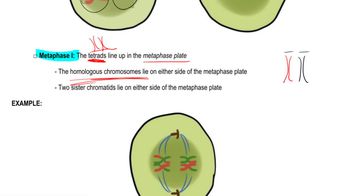Describe the 'folded-fiber' model of the mitotic chromosome.
Table of contents
- 1. Introduction to Genetics51m
- 2. Mendel's Laws of Inheritance3h 37m
- 3. Extensions to Mendelian Inheritance2h 41m
- 4. Genetic Mapping and Linkage2h 28m
- 5. Genetics of Bacteria and Viruses1h 21m
- 6. Chromosomal Variation1h 48m
- 7. DNA and Chromosome Structure56m
- 8. DNA Replication1h 10m
- 9. Mitosis and Meiosis1h 34m
- 10. Transcription1h 0m
- 11. Translation58m
- 12. Gene Regulation in Prokaryotes1h 19m
- 13. Gene Regulation in Eukaryotes44m
- 14. Genetic Control of Development44m
- 15. Genomes and Genomics1h 50m
- 16. Transposable Elements47m
- 17. Mutation, Repair, and Recombination1h 6m
- 18. Molecular Genetic Tools19m
- 19. Cancer Genetics29m
- 20. Quantitative Genetics1h 26m
- 21. Population Genetics50m
- 22. Evolutionary Genetics29m
9. Mitosis and Meiosis
Mitosis
Problem 27
Textbook Question
Consider a diploid cell that contains three pairs of chromosomes designated AA, BB, and CC. Each pair contains a maternal and a paternal member (e.g., Am and Ap). Using these designations, demonstrate your understanding of mitosis and meiosis by drawing chromatid combinations as requested. Be sure to indicate when chromatids are paired as a result of replication and/or synapsis.
Are there any possible combinations present during prophase of meiosis II other than those that you drew in Problem 26? If so, draw them.
 Verified step by step guidance
Verified step by step guidance1
Begin by understanding the chromosome composition: the diploid cell has three pairs of chromosomes (AA, BB, CC), each with a maternal (e.g., A^{m}) and paternal (e.g., A^{p}) homolog.
For mitosis, first illustrate the chromosomes before replication: each chromosome is a single chromatid (A^{m}, A^{p}, B^{m}, B^{p}, C^{m}, C^{p}). Then, show replication where each chromosome duplicates into two sister chromatids joined at the centromere (e.g., A^{m} consists of two identical sister chromatids).
For meiosis, during prophase I, depict homologous chromosomes pairing (synapsis) to form tetrads, where each homologous pair consists of four chromatids (two sister chromatids from each homolog). Indicate this synapsis for each pair (AA, BB, CC).
Recall that after meiosis I, homologous chromosomes separate, and in prophase II, each cell contains chromosomes with sister chromatids but no homologous pairs. Draw the chromatids in prophase II as pairs of sister chromatids (e.g., A^{m} chromatids together), without synapsis.
To answer the question about possible combinations during prophase II beyond those in Problem 26, consider whether any crossing over or recombination events could create new chromatid combinations. If so, illustrate chromatids with recombinant segments paired as sister chromatids, emphasizing that no homologous synapsis occurs at this stage.
 Verified video answer for a similar problem:
Verified video answer for a similar problem:This video solution was recommended by our tutors as helpful for the problem above
Video duration:
2mPlay a video:
Was this helpful?
Key Concepts
Here are the essential concepts you must grasp in order to answer the question correctly.
Chromosome Structure and Replication
Chromosomes consist of two sister chromatids joined at a centromere after DNA replication. In a diploid cell with pairs like AA, BB, and CC, each chromosome pair has one maternal and one paternal homolog. Replication occurs during the S phase, resulting in duplicated chromatids that remain attached until separated during cell division.
Recommended video:
Guided course

Chromosome Structure
Mitosis vs. Meiosis Chromatid Behavior
Mitosis involves separation of sister chromatids to produce identical diploid daughter cells, while meiosis includes two divisions: meiosis I separates homologous chromosomes, and meiosis II separates sister chromatids. Synapsis and crossing over occur only in meiosis I, affecting chromatid combinations seen in later stages.
Recommended video:
Guided course

Meiosis Steps
Prophase of Meiosis II and Chromatid Combinations
During prophase II, cells have haploid sets of chromosomes, each still composed of sister chromatids. Unlike prophase I, no synapsis occurs here, so chromatid combinations reflect prior recombination events. Understanding whether new combinations arise depends on recognizing that chromatids remain paired only as sisters at this stage.
Recommended video:
Guided course

Meiosis Steps
Related Videos
Related Practice
Textbook Question
962
views


